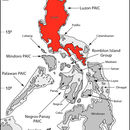pt-BR
nomes no trilho de navegação


According to the IUCN categories and classification structure, we consider the conservation status of this species as “Least Concern (LC),” pending the collection of additional information that might suggest otherwise.
Eutropis cumingi can be distinguished from congeners by the following combination of characters: (1) relatively small body size (39-54 mm SVL for mature adults); (2) dorsal and lateral scales with 5-7 or rarely 9 keels; (3) head shields embossed or ridged, at least posteriorly; (4) 28-32 midbody scale rows; (5) 40-47 vertebral scale rows between the parietals and the base of the tail; (6) 16-21 lamellae under the 4th toe; (7) 5-6 lamellae beneath the 1st toe; (8) large interparietal separating parietals; (9) 6-7 upper and lower labials; (10) tympanum deeply sunk, ear small, usually without lobules; (11) prominent, narrow dorsolateral stripe from posterior corner of eye to at least fore limb region (Brown & Alcala, 1980).
Color in preservative: Dorsal ground color brown to dark brown, relatively uniform except for darker, narrow lateral margins or with darker paravertebral rows or spots or lines; a narrow, light (whitish to bluish) dorsolateral stripe beginning at posterior corner of eye and extending to for limb region and in some specimens for varying distances along the trunk; a second, narrow light stripe extends from upper labials along side of head through ear and above forelimb, and may continue for varying distances along the flank; venter varies from light grayish ivory to grayish slate, with distinctly lighter areas beneath head and in regions of fore and hind limbs (Brown & Alcala, 1980).
Eutropis cumingi was originally known only from throughout the island of Luzon. Other specimens collected in recent surveys from islands throughout the Philippines also appear to represent E. cumingi, however a closer examination of these specimens is required to confirm this.
The name was chosen in honor of Hugh Cuming, who first collected this species.
Luzon Pleistocene Aggregate Island Complex (PAIC; Brown and Diesmos, 2002). However, Brown and Alcala (1980) indicate that a single specimen (CAS 140049) of this species from southern Luzon more closely resembles populations from Leyte, Mindanao, and Negros islands.
Eutropis cumingi appears to be primarily restricted to forested areas.
Eutropis cumingi is most similar to E. indeprensa and E. multicarinata, however it can be distinguished from both by color pattern differences and a combination of several scale counts.
39.5-54.0 mm SVL
San Felipe, Zambales Province, southern Luzon Island, Philippines; type in the Calfiornia Academy of Sciences
Eutropis cumingi, also known commonly as Cuming's eared skink, Cuming's mabouya, and Cuming's mabuya, is a species of lizard in the family Scincidae. The species is endemic to the Philippines.[2]
The specific name, cumingi, is in honor of English naturalist, Hugh Cuming, who collected the holotype.[2][3]
E. cumingi is found in the northern parts of the Philippines (Luzon, Calayan, Camiguin, and Lubang)[1] as well as in Orchid Island southeast of Taiwan.[1][4]
The preferred natural habitats of E. cumingi are forest and shrubland, at altitudes from sea level to 900 m (3,000 ft).[1]
E. cumingi preys upon cockroaches and other insects.[1]
E. cumingi is oviparous. Clutch size is two eggs.[2]
Eutropis cumingi, also known commonly as Cuming's eared skink, Cuming's mabouya, and Cuming's mabuya, is a species of lizard in the family Scincidae. The species is endemic to the Philippines.